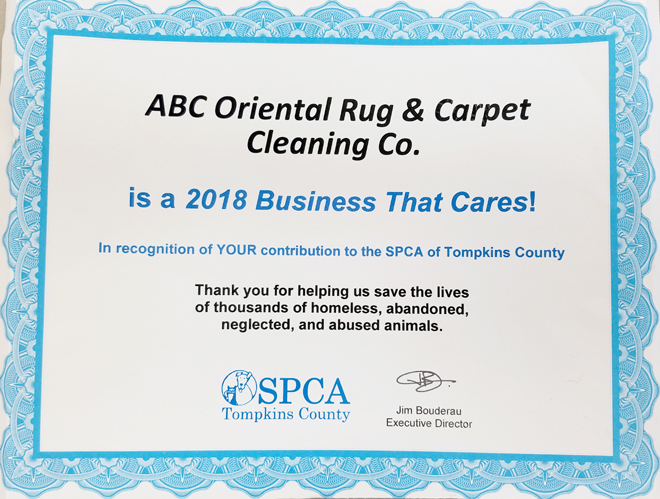ABC MONTHLY NEWSLETTER
SEPTEMBER 2020
Welcome to Our Monthly Newsletter!
We hope you will enjoy this month's articles.
This month's topics are:
COVID-19 PANDEMIC
AREA RUGS
MISCELLANEOUS
CONSIGNMENT RUGS FOR SALE REMINDER
If there is a topic you would like us to cover in one of our upcoming newsletters, please call us at
607-272-1566
or contact us by clicking here.
GREAT NEWS!
GOT QUESTIONS?
NOW YOU CAN TEXT US at
607-272-1566
SPECIAL NOTICE!!!
Due to COVID-19, ABC is suspending in home (residential) cleaning of upholstered furniture beginning September 1, 2020 for an indefinite period of time.
Commercial cleaning of upholstered furniture in businesses and fraternities and sororities will continue as usual.
We will continue to clean residential upholstery in our cleaning plant by appointment only (because of space restraints).
A
pick up and delivery service will no longer be provided for upholstered
furniture in the home. Please arrange to deliver your furniture to our
plant and pick up your cleaned items when done.
If you will need help in off loading or loading your upholstery, please call or text us first at 607-272-1566 so we can have the necessary people on hand to help.
We look forward to privilege of continuing to serve the professional upholstery cleaning needs of our customers in our cleaning plant.
MUTATIONS & COVID-19
Mutations in the natural world are normal and most happen without any real consequence. They are random and they are accidents. Unfortunately, the word itself has a bad connotation. The truth is that mutations have always been very important in creating the amazing diversity of the evolution of life.
In essence, we and every other living organism on the planet are mutants! When using the term mutant in reference to COVID-19 (which is also a mutant), it is important to understand how mutations arise and what they really mean in relation to a virus such as the novel coronavirus, in order to assuage our anxiety when we are told the COVID-19 coronavirus is mutating.
MUTATIONS ARE MISTAKES
Mutations are caused by mistakes the polymerase molecule (the enzyme found in every living thing that makes long chains of repeated units) sometimes makes when copying long strings of letters, such as those in our DNA. Just as a typist relies on spellcheck and the backspace key or a proofreader, most of these mistakes are corrected. But still, some go uncorrected and these mistakes are called mutations.
Mutations can have negative effects or they may have some beneficial effects to the survival of the organism, and some may have no effect at all on the living thing. Of course, mutations can also arise from other sources in our environment such as high-energy light waves (ultraviolet light, X-rays, gamma rays, etc.), many metals, certain chemicals, and certain viruses and bacteria, etc.
MUTATIONS IN DNA
Our DNA Code has redundancies built into it to keep mistakes (mutations) to a minimum.
The following is a simplified explanation of a DNA code:
Three sequential
letters are equivalent to one specific protein building block in the
code. For example, GGC tells the cell to reach for a glycine to add to
the growing protein chain. But GGA also means glycine. Thus, it is
apparent that the third letter is inconsequential because the DNA code
has redundancies.
So
if the DNA mutates from GGC to GGA, the protein will look the same. But
if the mutation turns GGC into ABC, the cell will add a different
building block altogether, which may affect how the protein performs.
The above example is of
a mutation affecting one letter, but there are all kinds of mutations,
like insertions, deletions, and massive changes that can wreak a lot
of havoc.
DNA vs. RNA
In humans and other mammals, our DNA contains genetic instructions that are copied into our RNA (Ribonucleic acid). The DNA stays in the cell's nucleus and the RNA then carries the copies of genetic information to the rest of the cell through a process that forms the proteins that carry out our bodily functions.
Viruses such as the coronavirus also have a genetic blueprint.
But, unlike in humans and other mammals, the genetic material for these
coronaviruses is encoded in RNA only.
The coronavirus also has a polymerase to make copies of its RNA
so that each new viral particle can carry this blueprint.
Unfortunately, this polymerase makes mistakes and mutations arise that
are not corrected, just like with the polymerase that codes our DNA.
When
the coronavirus RNA gets into our cells, it causes the protein
synthesis machinery of our cells to mistake it for the RNA produced by
our own DNA.
With most viruses, a sample will show that the RNA of all the viral particles is slightly different. These are mutations that are normal. This is because when mutations arise, they may not have any appreciable impact on the virus. But many diseases can occur when these mutations go awry!
TAKE AWAY... MUTATIONS ARE ACCIDENTS
It is most important to remember that mutations are just accidents. The accidents can be happy ones and some of these random mutations may end up helping a virus. But a virus does not have a brain, is not clever, and most mutations are neither good nor bad because they do not affect the code or recipe that carries the instructions on how to make a protein.
VIRUS MUTATIONS THAT MAKE A DIFFERENCE
The new coronavirus is an example of some mutations that do make a difference. The new virus needed to mutate in order to become good at infecting humans.
It certainly could be possible that in the future a mutation could arise in a gene that codes for the external part of the coronavirus, the part that gets recognized by our immune system as foreign. It would thus create a new strain of the virus to which we would not yet be immune. This happens a lot with RNA viruses. Luckily, it has not happened yet with the COVID-19 coronavirus and so far it appears to be genetically stable.
WHAT DO MUTATIONS MEAN FOR THE DEVELOPMENT OF AN EFFECTIVE VACCINE?
Please continue reading here for the answer as well as other topics such as traditional vaccines vs RNA vaccines, the reason why the measles vaccine from the 1950s still works but the flu vaccine has to be developed anew each year, etc.
MOTHS in AREA RUGS
THE CLOTHES MOTH HAS NOT BEEN ELIMINATED!!
In past years, textile-eating moths were common, due to the large amount of wool fibers in clothing and home furnishings. The popularity and widespread use of synthetic fibers has led to the incorrect assumption that damage from these insects is a thing of the past.
Clothes moths
can digest protein fibers such as wool, silk and specialty hair
fibers, but these insects will also find and eat protein substances on
synthetic fibers. This means carpets, rugs, draperies, and upholstery
made from nylon, acrylic, polyester, acetate, and other synthetics can
harbor these insects if they contain food or beverage stains, blood,
urine, perspiration or other sources of nutritional protein.
HOW TO PREVENT MOTHS
The most effective way to prevent an
infestation and inhibit growth is to keep textile furnishings clean.
Spills should be removed immediately. Carpet, rugs, draperies,
upholstery, etc., should be brushed or vacuumed regularly, as insects
do not generally attack clean materials.
Regular dry cleaning of articles
appropriate for dry cleaning will also decrease the chances of
infestation because dry cleaning solvent is toxic to most textile
pests. Regular carpet and rug cleaning will remove the nutritional
contaminants that can attract and support insects.
WHAT ARE THEY?
There are 2 different types of these pests that we need to be concerned about. Both are types of clothes moths, the insect that eats our textiles.
- The Webbing Moth (Tineola bisselliella). The adult moths of this species are about a half inch long and yellowish beige in color.
- The Casemaking Moth (Tinea pellionella). Casemaking moths are similar in size but are brownish and have three dark spots on their forward wings.
THE LARVAE CAUSE THE DAMAGE
The adults
themselves cause no damage, but the larvae they produce are very
damaging. It is the larvae that actually feed on wool.
Each
larva spins a silken tube that acts like a barrier of protection. The
webbing moth larvae attach their tubes to dark crevices or seams,
rendering themselves stationary to feed in one location. The casemaking
moth larvae do not attach their tubes or "cases" which allows them to
remain mobile and cause a wider spectrum of damage.
THE LIFE CYCLE OF MOTHS
The life cycle of moths can last from two months to two and ½ years. The adults lay eggs on products that the larvae will consume.
Each female can lay from 100 to 150 eggs,
which hatch in about five days. The small white caterpillars vary in
size from 1/16 inch newly hatched to 1/3 inch fully grown. The larval
stage itself can last from 2-30 months.
The great variance in the life cycle is due to the availability of food (wool). That is why these creatures can be so devastating to rugs. Rugs provide a huge source of food. If gone unnoticed, the larvae can feed for almost two and ½ years. An infestation of only several weeks can result in pile loss the size of a fist.
WHERE TO FIND THEM
Clothes moths thrive in dark, undisturbed areas where a rug gets little traffic and is not often vacuumed. They are particularly attracted to the keratin in animal hair. The wool alone in an oriental rug is susceptible, but just imagine a dirty rug covered in dog and cat hair. That would be like a smorgasbord to this creature! They can feed on mixtures of natural and synthetic fabrics. However, they cannot feed on materials made solely of synthetic fibers. As mentioned above, they can be found in synthetic fibers which have pollen, hair, dead insects and dried animal remains on them.
HOW DO YOU KNOW IF YOU ARE HARBORING MOTHS?
Find out how to know, how to get rid of moths and more by clicking here. And don't forget to order our September special (see below) of 25% off Moth Treatment and Moth Repel on any wool rugs cleaned in our plant all month!
AGGRESSIVE RUG AGING
Aggressive rug aging is one of the latest techniques used to make brand new rugs look like old or 'antique rugs.' Unfortunately, the process is aggressive to the extreme, even to the point of actually leaving the rugs threadbare!
These types of rugs are often called 'distressed rugs.' But the only ones who will be distressed are the homeowners, when their brand new rug falls apart in a short period of time!
PAST TREATMENTS TO AGE RUGS
In the past few decades the process for making rugs look older was to give them either a 'luster wash' to fade the colors, or a 'tea wash' to cover the rug in a dark tone to mute the colors.
Those past treatments usually kept the wool pile in place. They could be compared to getting just highlights of color applied to hair to make it look sun-kissed and shiny, but without changing the length.
The current trend of rug aging is MUCH more aggressive. Instead of 'highlighting,' it is more like aggressively bleaching and shaving a head of hair with a razor blade to leave bleached, jagged roots!
WHY IS MORE AGGRESSIVE TREATMENT BEING USED?
Rug dealers understandably follow what consumers appear to want in order to sell their rugs. People seeking rugs for their home spaces currently like the faded, soft look that can be attained with these aggressive treatments.
Unfortunately, the homeowner would also expect a soft wool texture, but because of the strong chemicals used with this aggressive rug aging process, the rug will not only have a harsh texture but a very strong chemical odor as well, one that may actually make the homeowner fall ill!
Rug dealers charge thousands of dollars for these trendy, chemically filled rugs. They may tell the homeowner the rug is safe to put in a child's room and to just air it out--but is it?
When you look at the back of one of these rugs you can see how much of the wool has been eaten away. The rug will be sold as a 'new wool rug.' But where is the wool?
The back of the rug will contain a lot of cotton warps and wefts (foundation cords). The wool that remains in the rug will be peeking through here and there, but the rug will essentially be be a cotton foundation with few actual wool 'knots' remaining. Faint darker tones may be a hint of what the original colors were.
To create this condition in a new rug requires some EXTREMELY strong chemicals to bleach and eat away the wool. The rug is shaved very short and then the rug is soaked in a chemical vat with the sole purpose of deteriorating and dissolving the wool fibers and dyes.
WHAT DOES THIS AGGRESSIVE RUG TREATMENT MEAN FOR BUYERS?
A person who purchases this type of rug generally likes to have wool rugs in the home because they are durable and hide dirt really well. They are also expected to last for decades with proper care. But buyer beware! This type of rug is now more of a cotton rug than a wool rug and it is 'damaged goods.'
There are some very important things to consider:
The Aggressive Chemical Process Damages the Rug
When a rug has been heavily bleached front and back with this aggressive rug aging process, it has been soaked in a chemical vat for a long time. The rug is essentially ruined when it is damaged to this level.
The Fringe Fibers Are Also Ruined
This process will also leave the fringe tassels fluffy white and frayed. They are no longer twisted as they should be. If we just grab the fringes, the threads will easily pull away.
The Chemicals Will Have Also Ruined the Cotton Foundation
All the absorbent interior cotton fibers of the foundation have fully absorbed those chemicals. If the fringes can be easily pulled away with your fingers, this means the same chemicals have also damaged the cotton throughout the rug. This is because each of those cotton fringe tassels runs all the way through the middle of hand knotted rugs to the opposite side. If the new rug has damaged fringes, it should signify to the buyer that the interior cotton is also damaged.
Chemicals from the Rug Will be Released into the Home
Please continue reading here for more information on these types of rugs and how ABC can help.
LABOR DAY
Labor Day is celebrated on the first Monday in September of every year. This year, of course, with the pandemic upon us, some of us are more than likely wishing we had some labor to celebrate.
Nonetheless, this year marks the 126th celebration of Labor Day. It is the only holiday in the year that does not focus on an individual or a national event.
The path to this proclamation was not a simple one. Rather, it was marked with hard work and risk by labor leaders and many thousands of workers. It was a celebration by the Knights of Labor in 1882 that brought the cause to the public's attention.
Hundreds of thousands of demonstrators paraded in New York City in America's first Labor Day parade. Many carried signs that said '8 hours for work, 8 hours for rest, 8 hours for recreation.' Of course, they were parading for better working conditions as well.
The Labor Day movement spread from East to West in the following years. In 1887, Colorado was the first state to declare Labor Day a state holiday. By 1893, more than half of the states had an official Labor Day. President Grover Cleveland, thinking it was a good political move, signed the bill for a national Labor Day on June 28, 1894. Unfortunately, he was not reelected.
WHY A LABOR DAY HOLIDAY?
The original intent of Labor Day was to provide a holiday that would honor the social and economic achievements of America's blue collar workers, representing the millions who worked with their hands. Public festivities varied from parades and formally planned picnics to speeches and the recognition of particularly worthy individuals. It was also intended to provide a day of rest between the 4th of July and Thanksgiving.
Today, Labor Day celebrates all American workers and
their contributions to our nation. Monday was chosen because the
three-day weekend offers an opportunity to step away (for most) from
business, work at a store, hospital, office, plant, etc.
It can be a weekend of rest and the recharging of our batteries, as well as doing the things with our family and friends that will soon be impractical because of the changing season and busy schedules. Since it is the last major holiday before the onset of autumn, Labor Day is generally seen as the last chance to enjoy the summer season.
WHO HAS TO WORK ON LABOR DAY?
Here are some groups of people, identified by Wall Street as essential 24/7, who have to work on Labor Day. Some of them even have to work harder on the national day off.
1. Corrections Officers.
2. Electrical Power Linemen.
3. Police and Sheriff's Officers.
4. Nuclear Power Reactor Operations.
5. Air Traffic Controllers.
6. Telecommunications Installers & Repair People.
7. Railroad Conductors and Yardmen.
8. Firefighters.
9. Water & Wastewater System Operators.
10.Registered Nurses.
ONE LABOR DAY TRADITION THAT IS GONE FOREVER
To find out more, please continue reading here.
SEPTEMBER CLEANING SPECIALS
SPECIAL #1
25% OFF
Moth Treatment and/or Repel applied
to any Wool Rug
Cleaned in our Plant
SPECIAL #2
$25$ OFF
Soil & Stain Protection
applied to wall-to-wall carpets cleaned in your Home
(traffic areas & stairs)
See our article on Soil & Stain Protector
THANK YOU!! WE LOOK FORWARD TO CONTINUING TO SERVE YOUR TEXTILE CLEANING AND REPAIR NEEDS!
Get New Posts Right To Your Inbox!
Get our monthly newsletter, just like this one, delivered right to your inbox each day. Just sign up and we will send you the best new articles and videos as they become available.
Your email address will NEVER be spammed, sold, or shared. You are welcome to unsubscribe at any time with the link in the email.
Top of September 2020 Newsletter
"The Cleanest Clean You've Ever Seen."
by
ABC Oriental Rug & Carpet Cleaning Co.
130 Cecil Malone Drive Ithaca, NY 14850
607-272-1566

ABC
Carpet & Rug
Spotting Guide

ABC Oriental Rug & Carpet Cleaning Co. has been family-owned and operated in Ithaca and surrounding areas for more than 49 years.
Our company is a reflection of our family name and pride.
Please Like us on Facebook!
for more information and to find out what we are doing at our business and in the community!
Stay Connected!
Links to Our Services
Allergy Cleaning
Area Rug Cleaning
Oriental Rug Cleaning
Rug Hand & Machine Repair
Upholstered Furniture Cleaning
Tile & Grout Cleaning & Sealing
We are proud sponsors of the SPCA of Tompkins CO:

Newsletter Archives Categories
~~~~~
~~~~~
Area Rugs & Wall-to-Wall Carpet
~~~~~
General Cleaning, Do-It-Yourself, & Green Cleaning
~~~~~
Wood Floor Coverings & Alternatives
~~~~~
~~~~~
Ceramic Tile & Grout Cleaning & Sealing
~~~~~
Health & Environmental Concerns
~~~~~
~~~~~




